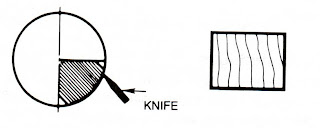Veneer, the thin sheet layer of wood
Veneer (wood veneer) is a thin sheet of wood. It is much used to layer the
m.d.f., particle board to produce wood looked surface. The veneer industry is
big scale in the woodworking industry. The wood veneers from any type of wood
are available in the market to supply the woodworking industry. If you need a
wood veneer then you can find supplier and order according to your need. But do
you know how wood veneer is made? In this article we want to share about the
process to make veneer.
Veneer is made from the wood, so the manufacture of veneer is started by cutting the tree. All types of tree can be used to make wood veneer, but usually the wood with nice looked are used. The nice exotic and expensive wood such as: ebony, rosewood, pavero, zebrano, etc. are used to make veneered panel with special wood looked. While the common wood such as: oak, pine, cherry, maples are also much used to make veneer. If the exotic woods are used to make special inlay in the wood looked panel, the common wood veneer are used to make the better wood looked panels. The wood veneer with high grade can be obtained with cheaper than the wood plank panels.
Veneer is made from the wood, so the manufacture of veneer is started by cutting the tree. All types of tree can be used to make wood veneer, but usually the wood with nice looked are used. The nice exotic and expensive wood such as: ebony, rosewood, pavero, zebrano, etc. are used to make veneered panel with special wood looked. While the common wood such as: oak, pine, cherry, maples are also much used to make veneer. If the exotic woods are used to make special inlay in the wood looked panel, the common wood veneer are used to make the better wood looked panels. The wood veneer with high grade can be obtained with cheaper than the wood plank panels.
The trees that are used to make
veneer should be long enough, has a straight trunk and quite big in the
diameter. The timber for veneer usually is better quality than the trees used
to make the wood panel. Some type of timber log is hard and brittle; it should
be soaked or boiled first before being sliced. Soaking the wood will make the wood
to be soft, elastic and reduce the problem in the slicing process. The tough
and brittle wood may need to be boiled to get soften.
The wood stem is peeled by a rotary
knife to clean off the skin and sap wood to make the long wood trunk with same
size diameter from one end to the end. This log then is going to be sliced to
form veneer. There are various techniques of slicing: rotary slicing, flat cut slicing, half cut
slicing, quarter cut slicing and rift cut slicing. Each of cutting technique
will give different types of veneer and give the difference appearance in the
term of grain pattern. The different model of veneer slicing can be viewed below.
rift cut slicing
flat cut slicing
The next process is grading and
separating the veneers according to its quality. There are several grade of
veneer according to its quality. By length, the veneer is grouped into three:
the architectural grade, furniture grade and flooring grade. Architectural
grade, this is the longest veneer, up to 2.2 m - 3.4 meter length. It is used
to layer the specific forms of the building or home to make special architectural model. The
furniture grade is the veneer for the furniture industry.
Its size is according to make panels for furniture such as: side panels, top panels for
cabinet or table. Some special
furniture model that needs the longer veneer will need the architectural grade
veneer. The flooring grade is the shortest veneer with 1 meter length. It used
to make engineered flooring parquet, which is usually need the short panel.
The veneer is also graded according
to its defect as the wood panel. Veneer with a grade is the best quality; it is the veneer with
clean surface free from the eye, hole, crack and other defects. The B grade is the veneer with some defect or knot, if more defects are existed then the veneer is grouped in the C or D grade.
The architectural A grade veneer is
the most expensive, it means the veneer has clean and good surface for 3 meter
length. It is the sheet that first explored and separated from the bulk of the
sliced wood. The good performance sheet with some defect can be cut to go to
the furniture grade or flooring grade. The low performance veneer can also go
to the b grade or c grade. The A or B grade are used to make the face panel,
while the C or D grade can be used to layer the back panel or to be used as the
banded core.
Veneer storage.
As product from wood, the veneer is hygroscopic material that is susceptible to the changes of the air humidity. The changes in the environmental humidity will caused to the shrinkage or swelling that could damage the veneer. Therefore, the veneer should be stored in a conditioning room which has a stable humidity. In the room the veneer sheet with same quality, sizes and type are bundled and stored in the same place.
Applications and Uses
The wood veneer has widely used in the woodworking industry. It mostly used to make panel for any indoor uses. It has many advantages for panel making such as : more stable, more flexible and less expensive then the solid wood. With his advantage veneer has lot uses in woodworking industry such as: furniture, architectural product, door, floor, marquetry, and all other wood looked product






Stupendous blog you guys have provided there, I will absolutely valuate your effort.
ReplyDeleteclick over here